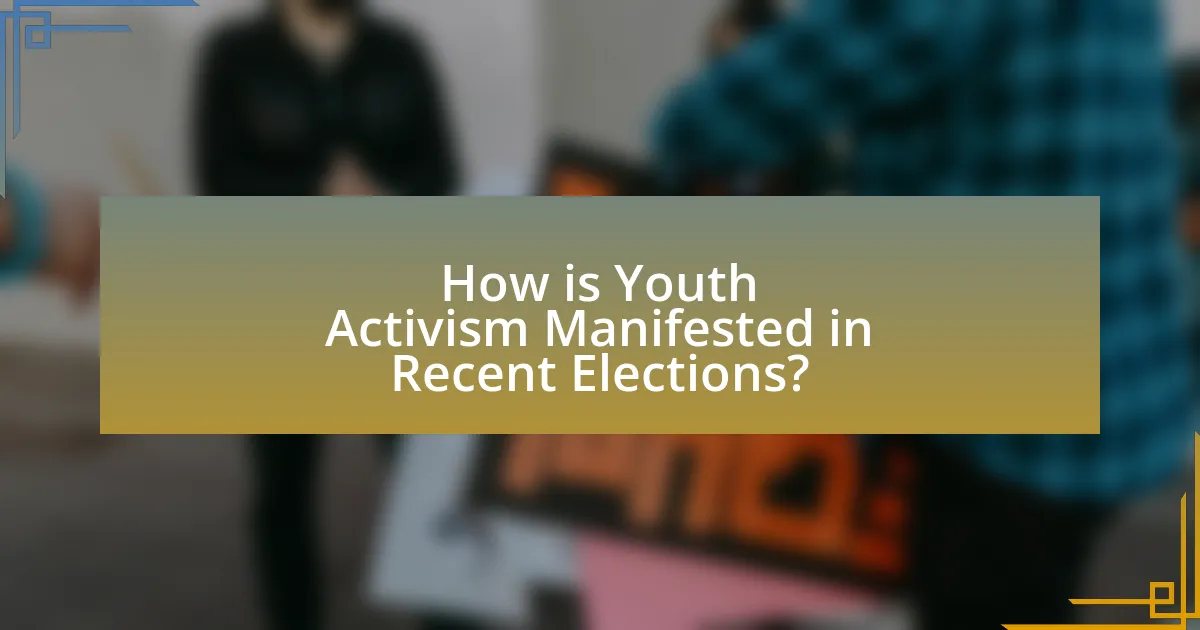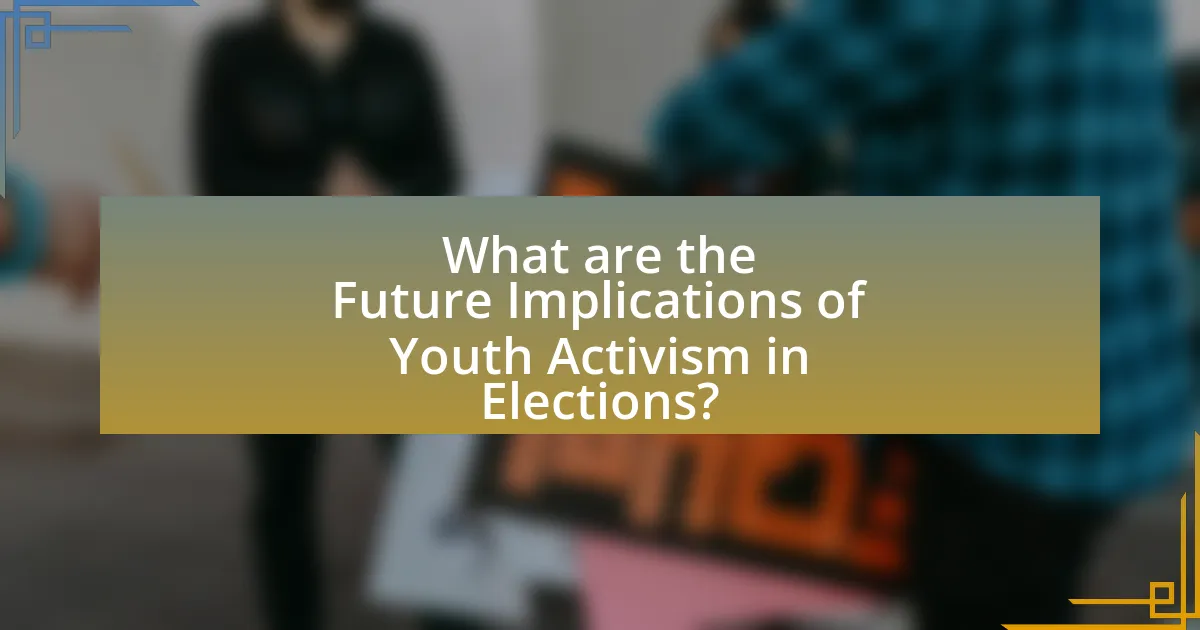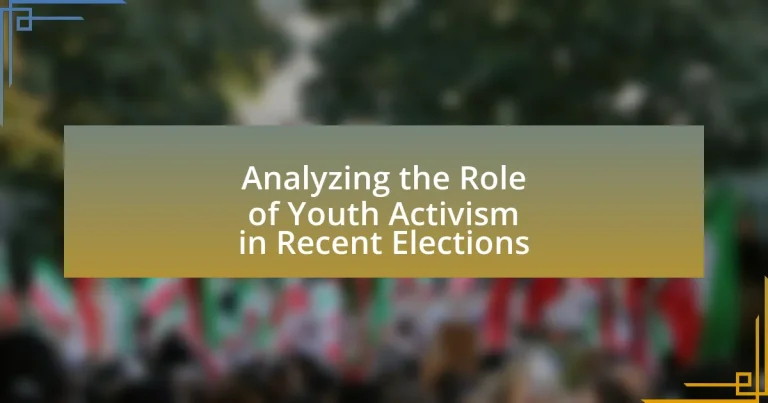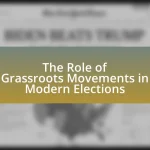Youth activism has emerged as a significant force in recent elections, notably influencing voter turnout and political discourse. The 2020 U.S. presidential election saw a historic 50% turnout among voters aged 18-29, driven by movements advocating for climate change, racial justice, and gun control. This article analyzes the impact of youth-led initiatives, such as March for Our Lives and Fridays for Future, on electoral outcomes and political priorities. It also explores the challenges faced by youth activists, the role of social media in mobilization, and the evolving landscape of youth engagement in democracy, highlighting the importance of addressing issues that resonate with younger voters.

What is the Role of Youth Activism in Recent Elections?
Youth activism has played a crucial role in recent elections by significantly influencing voter turnout and shaping political discourse. For instance, in the 2020 U.S. presidential election, youth voter turnout reached 50%—the highest level for this demographic in decades—according to the U.S. Census Bureau. This surge was largely driven by organized movements advocating for issues such as climate change, racial justice, and gun control, which resonated with younger voters. Additionally, platforms like TikTok and Instagram have been utilized by youth activists to mobilize peers and disseminate information, further amplifying their impact on electoral outcomes.
How has youth activism influenced electoral outcomes?
Youth activism has significantly influenced electoral outcomes by mobilizing young voters and shaping political discourse. For instance, in the 2020 U.S. presidential election, youth turnout reached 50% compared to 36% in 2016, largely driven by movements such as Black Lives Matter and climate activism, which resonated with younger demographics. Research from the Center for Information & Research on Civic Learning and Engagement (CIRCLE) indicates that issues like climate change and racial justice motivated young voters to participate, ultimately contributing to Joe Biden’s victory. This demonstrates that youth activism not only increases voter engagement but also impacts the priorities of political candidates and parties.
What specific movements have emerged from youth activism?
Specific movements that have emerged from youth activism include the March for Our Lives, which advocates for gun control following the Parkland shooting, and the Fridays for Future movement, initiated by Greta Thunberg to address climate change. These movements have mobilized millions of young people globally, demonstrating significant influence on public policy and awareness. For instance, March for Our Lives organized a nationwide rally in 2018 that drew over 800,000 participants in Washington, D.C., highlighting the urgency of gun reform. Similarly, Fridays for Future has inspired global climate strikes, with millions participating in events worldwide, emphasizing the demand for immediate action on climate issues.
How do these movements mobilize young voters?
Movements mobilize young voters by leveraging social media platforms to disseminate information rapidly and engage them in political discourse. For instance, the 2020 U.S. presidential election saw organizations like March For Our Lives and Sunrise Movement utilize Instagram and TikTok to reach younger demographics, resulting in a significant increase in voter turnout among those aged 18-29, which rose to 50% compared to 36% in 2016. This strategic use of digital communication not only informs young voters about issues but also fosters a sense of community and urgency around civic participation, effectively translating online engagement into real-world voting action.
Why is youth activism important in the context of democracy?
Youth activism is important in the context of democracy because it empowers young individuals to influence political processes and advocate for social change. This engagement fosters a more inclusive political landscape, as youth bring fresh perspectives and innovative solutions to pressing issues. For instance, the 2020 U.S. elections saw a significant increase in youth voter turnout, with the U.S. Census Bureau reporting that 50% of eligible voters aged 18-29 participated, compared to 36% in 2016. This surge demonstrates how youth activism can directly impact electoral outcomes and policy discussions, highlighting the critical role young people play in shaping democratic governance.
What historical precedents exist for youth activism in elections?
Historical precedents for youth activism in elections include the Student Nonviolent Coordinating Committee (SNCC) during the Civil Rights Movement, which mobilized young people to register voters and participate in protests, significantly impacting the 1964 and 1965 elections. Additionally, the anti-war protests during the Vietnam War era saw youth organizing to influence public opinion and policy, culminating in the 26th Amendment, which lowered the voting age to 18 in 1971. These movements demonstrate how youth activism has historically shaped electoral outcomes and policy changes.
How does youth activism shape political discourse?
Youth activism significantly shapes political discourse by introducing fresh perspectives and mobilizing collective action among younger generations. This engagement often leads to the prioritization of issues such as climate change, social justice, and education reform in political discussions. For instance, movements like Fridays for Future, initiated by Greta Thunberg, have successfully brought climate change to the forefront of political agendas globally, influencing policy debates and electoral platforms. Additionally, studies show that youth-led initiatives can increase voter turnout and political participation, as seen in the 2020 U.S. elections where young voters played a crucial role in shaping outcomes. This active involvement not only alters the topics of discussion but also challenges traditional political narratives, making youth voices essential in contemporary political discourse.
What challenges do youth activists face in elections?
Youth activists face several challenges in elections, including limited access to resources, political apathy among peers, and systemic barriers within the electoral process. Limited funding and organizational support hinder their ability to mobilize effectively, as many youth-led initiatives operate on tight budgets. Additionally, political apathy among young voters can lead to lower engagement, making it difficult for activists to rally support for their causes. Systemic barriers, such as voter ID laws and registration requirements, disproportionately affect young people, further complicating their participation in the electoral process. These challenges collectively impede the influence and effectiveness of youth activism in shaping electoral outcomes.
How do systemic barriers impact youth participation?
Systemic barriers significantly hinder youth participation by creating obstacles that limit access to resources, opportunities, and decision-making processes. For instance, socioeconomic disparities often prevent young individuals from engaging in political activities due to financial constraints, lack of transportation, or insufficient access to information. According to a study by the Pew Research Center, only 50% of eligible voters aged 18-29 participated in the 2020 election, highlighting how these barriers can lead to lower engagement rates among youth compared to older demographics. Additionally, systemic issues such as discrimination based on race or gender further marginalize specific groups of youth, reducing their ability to participate fully in civic activities.
What role does social media play in overcoming these challenges?
Social media serves as a crucial tool for youth activism by facilitating communication, mobilization, and awareness around political challenges. It enables young activists to share information rapidly, organize events, and engage with a broader audience, thereby amplifying their voices. For instance, during the 2020 U.S. elections, platforms like Twitter and Instagram were instrumental in mobilizing youth voter turnout, with studies indicating that social media campaigns significantly increased engagement among younger demographics. This demonstrates that social media not only helps in overcoming barriers to participation but also fosters a sense of community and collective action among youth activists.

How is Youth Activism Manifested in Recent Elections?
Youth activism is manifested in recent elections through increased voter turnout, social media mobilization, and advocacy for issues like climate change and racial justice. In the 2020 U.S. presidential election, for example, voters aged 18-29 represented 50% of the electorate, a significant increase from previous years, according to the U.S. Census Bureau. Additionally, platforms like TikTok and Instagram have been utilized to spread awareness and encourage political participation, exemplified by campaigns such as #Vote2020. This engagement has led to a greater focus on youth-centric policies, as candidates recognize the influence of young voters on election outcomes.
What strategies do youth activists use to engage voters?
Youth activists engage voters through strategies such as social media campaigns, grassroots organizing, and educational outreach. Social media campaigns leverage platforms like Instagram and TikTok to reach younger demographics, effectively disseminating information and mobilizing support; for instance, the #VoteReady campaign in 2020 successfully encouraged millions of young people to register and vote. Grassroots organizing involves community events and door-to-door canvassing, which fosters personal connections and encourages voter participation; studies show that face-to-face interactions significantly increase voter turnout. Educational outreach includes workshops and informational sessions that inform peers about voting rights and the electoral process, enhancing civic knowledge and engagement. These strategies collectively empower youth to influence electoral outcomes and increase voter participation among their peers.
How effective are grassroots campaigns led by youth?
Grassroots campaigns led by youth are highly effective in mobilizing communities and influencing political outcomes. Research indicates that youth-led initiatives often leverage social media to engage peers, resulting in increased voter turnout; for instance, the 2020 U.S. elections saw a 50% increase in voter participation among 18-29-year-olds, largely attributed to youth activism. Additionally, studies show that youth-led campaigns can shift public opinion on critical issues, such as climate change and social justice, by raising awareness and fostering dialogue. These campaigns not only empower young leaders but also create lasting impacts on policy and community engagement.
What role do educational initiatives play in mobilizing youth?
Educational initiatives play a crucial role in mobilizing youth by providing them with the knowledge and skills necessary to engage in civic activities. These initiatives often include programs that educate young people about their rights, the electoral process, and the importance of participation in democracy. For instance, studies have shown that youth who participate in educational programs about voting are significantly more likely to vote in elections. According to a report by the Center for Information & Research on Civic Learning and Engagement, youth voter turnout increased by 10% in areas where schools implemented civic education programs. This demonstrates that educational initiatives not only inform youth but also empower them to take action, thereby enhancing their involvement in democratic processes.
What issues are most important to young voters?
The most important issues to young voters include climate change, student debt, healthcare access, and social justice. Climate change is a top priority, with 76% of young voters expressing concern about its impact on their future, according to a 2020 survey by the Harvard Institute of Politics. Student debt is also critical, as approximately 45 million Americans owe a collective $1.7 trillion, significantly affecting young people’s financial stability and life choices. Access to affordable healthcare remains vital, especially in the wake of the COVID-19 pandemic, with many young voters advocating for universal healthcare solutions. Lastly, social justice issues, including racial equality and LGBTQ+ rights, resonate strongly, as seen in the increased youth participation in movements like Black Lives Matter. These issues collectively shape the political engagement and voting behavior of young voters in recent elections.
How do these issues differ from those prioritized by older generations?
Youth activism issues, such as climate change, social justice, and mental health, differ significantly from those prioritized by older generations, who often focus on economic stability, healthcare, and retirement security. For instance, a 2021 Pew Research Center study found that 75% of younger individuals view climate change as a critical issue, while only 45% of older adults prioritize it similarly. This generational divide highlights a shift in focus, with younger activists advocating for immediate action on environmental concerns and systemic inequalities, contrasting with older generations’ emphasis on traditional economic and social safety nets.
What impact do these issues have on voting behavior?
Youth activism significantly influences voting behavior by increasing political engagement and turnout among younger demographics. Research indicates that issues such as climate change, social justice, and economic inequality resonate strongly with young voters, motivating them to participate in elections. For instance, a study by the Center for Information & Research on Civic Learning and Engagement (CIRCLE) found that youth voter turnout in the 2020 election reached 50%, a notable increase from previous years, largely driven by activism surrounding these critical issues. This heightened engagement reflects a shift in priorities, where young voters are more likely to support candidates who align with their values on these pressing matters.
How do political parties respond to youth activism?
Political parties respond to youth activism by adapting their platforms, engaging in dialogue, and mobilizing resources to address the concerns raised by young activists. For instance, in the 2020 U.S. elections, many parties incorporated climate change and social justice issues into their campaigns, reflecting the priorities of youth movements like the Sunrise Movement and Black Lives Matter. This adaptation is evident in the Democratic Party’s emphasis on progressive policies, which was influenced by the activism of younger voters who prioritize these issues. Additionally, political parties often utilize social media to connect with youth, recognizing that platforms like Instagram and TikTok are crucial for reaching this demographic. This strategic engagement demonstrates that political parties are increasingly aware of the impact of youth activism on electoral outcomes and policy formulation.
What changes have been made to party platforms to attract young voters?
Party platforms have increasingly incorporated progressive policies to attract young voters, focusing on issues such as climate change, student debt relief, and social justice. For instance, the Democratic Party has emphasized the Green New Deal, which aims to address environmental concerns and create jobs in renewable energy, appealing to the younger demographic that prioritizes sustainability. Additionally, proposals for comprehensive student loan forgiveness have gained traction, reflecting the financial burdens faced by younger generations. According to a 2020 Pew Research study, 61% of young voters identified climate change as a top priority, underscoring the effectiveness of these platform changes in resonating with their values and concerns.
How do political candidates engage with youth activists?
Political candidates engage with youth activists through targeted outreach, social media campaigns, and participation in youth-led events. Candidates often utilize platforms like Instagram and TikTok to connect with younger audiences, recognizing that these channels are effective for disseminating their messages and mobilizing support. For instance, during the 2020 U.S. presidential election, candidates like Joe Biden and Bernie Sanders actively engaged with youth activists by participating in virtual town halls and forums focused on issues such as climate change and social justice, which resonate strongly with younger voters. This engagement strategy is supported by research indicating that youth voter turnout increased significantly in 2020, with 50% of eligible voters aged 18-29 casting ballots, compared to 39% in 2016, highlighting the effectiveness of candidates’ outreach efforts.

What are the Future Implications of Youth Activism in Elections?
Youth activism in elections is likely to lead to increased voter turnout and greater political engagement among younger demographics in the future. This trend is supported by the significant participation of youth in recent elections, such as the 2020 U.S. presidential election, where voters aged 18-29 increased their turnout to 50%, up from 36% in 2016, according to the U.S. Census Bureau. As young activists continue to mobilize around issues like climate change, social justice, and education reform, their influence on policy and candidate selection is expected to grow, potentially reshaping political agendas to better reflect their priorities. This shift indicates that political parties may increasingly cater to youth concerns to secure votes, thereby altering the traditional political landscape.
How might youth activism evolve in future elections?
Youth activism is likely to evolve in future elections through increased digital engagement and intersectionality. As technology advances, young activists will leverage social media platforms for organizing, mobilizing, and raising awareness, similar to the impact seen during the 2020 U.S. elections where platforms like TikTok played a significant role in voter engagement. Additionally, the focus on intersectionality will grow, as youth increasingly advocate for diverse issues such as climate change, racial justice, and gender equality, reflecting the multifaceted concerns of their generation. This evolution is supported by studies indicating that younger voters are more likely to prioritize candidates who address a range of social issues, as evidenced by the 2022 midterm elections where youth turnout was driven by candidates’ stances on climate and social justice.
What trends are emerging in youth political engagement?
Emerging trends in youth political engagement include increased use of social media for activism, a focus on climate change and social justice issues, and higher participation in grassroots movements. Social media platforms like Instagram and TikTok have become vital tools for mobilizing young voters, as evidenced by the significant role they played in the 2020 U.S. elections, where youth voter turnout reached 50% compared to 36% in 2016. Additionally, surveys indicate that 75% of young people prioritize climate action, reflecting a shift towards environmental advocacy as a central theme in their political engagement. Grassroots movements, such as those led by organizations like Sunrise Movement, have also gained traction, demonstrating a collective effort among youth to influence policy and demand accountability from leaders.
How can technology further enhance youth activism?
Technology can further enhance youth activism by providing platforms for organization, communication, and mobilization. Social media platforms like Twitter and Instagram enable young activists to share their messages widely, connect with like-minded individuals, and organize events quickly. For instance, the 2019 climate strikes, driven by youth activists using social media, mobilized millions globally, demonstrating the power of technology in amplifying their voices. Additionally, tools like online petitions and crowdfunding platforms facilitate resource gathering and support for various causes, making activism more accessible and impactful.
What lessons can be learned from recent youth-led movements?
Recent youth-led movements demonstrate the power of collective action and digital mobilization in driving social change. These movements, such as the climate strikes initiated by Greta Thunberg and the Black Lives Matter protests, highlight that young people can effectively influence public discourse and policy. For instance, the 2020 U.S. elections saw a significant increase in youth voter turnout, with the U.S. Census Bureau reporting that 50% of eligible voters aged 18-29 participated, compared to 36% in 2016. This indicates that youth activism can translate into political engagement and impact electoral outcomes. Additionally, these movements emphasize the importance of intersectionality, as they often address multiple social justice issues simultaneously, fostering a more inclusive approach to activism.
How can these lessons inform future electoral strategies?
Lessons from youth activism can inform future electoral strategies by emphasizing the importance of engaging younger voters through digital platforms and grassroots movements. Historical data from the 2020 U.S. elections showed that voter turnout among those aged 18-29 increased significantly, driven by social media campaigns and issues like climate change and social justice. This indicates that future strategies should prioritize online engagement and address the specific concerns of younger demographics to mobilize their support effectively.
What best practices can youth activists adopt for greater impact?
Youth activists can adopt several best practices for greater impact, including building coalitions, leveraging social media, and engaging in grassroots organizing. Building coalitions with diverse groups enhances collective strength and broadens the reach of their message, as seen in movements like the March for Our Lives, which united various organizations to advocate for gun control. Leveraging social media allows activists to disseminate information rapidly and mobilize supporters effectively; for instance, the #BlackLivesMatter movement utilized platforms like Twitter to raise awareness and organize protests. Engaging in grassroots organizing fosters community involvement and empowers local voices, exemplified by the Sunrise Movement’s efforts to mobilize young people around climate change issues. These practices have been shown to increase visibility, foster collaboration, and amplify the voices of youth activists in the political arena.
What practical steps can young people take to become more involved in elections?
Young people can become more involved in elections by registering to vote, participating in local campaigns, and educating themselves about candidates and issues. Registering to vote is crucial, as statistics show that voter turnout among young people increased from 50% in the 2016 election to 53% in 2020, indicating a growing engagement. Additionally, volunteering for political campaigns allows young individuals to gain firsthand experience and influence the electoral process. Engaging in discussions about policies and attending town hall meetings further enhances their understanding and involvement. These steps collectively empower youth to actively shape their political landscape.


